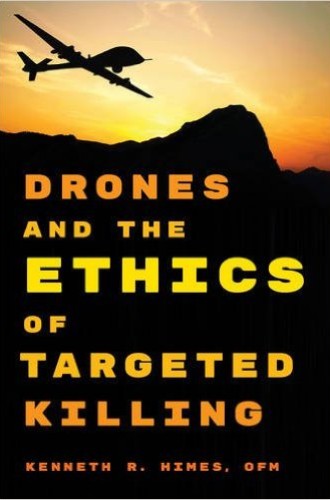The morality of drone warfare
Drones are the United States’ leading counterterrorist weapon. The military has used them for reconnaissance, troop support, and direct attacks in Afghanistan and Iraq. The CIA has used them to attack suspected terrorists, sometimes killing innocent bystanders. Covert drone strikes over the past decade are estimated to have killed between 2,000 and 4,000 people in Pakistan, several hundred in Yemen, and up to 100 in Somalia. These strikes, which are popular with the American public, are likely to become more frequent. But should drones be relied on? Should the public be so supportive? Citizens and political leaders cannot assess the counterterrorist actions carried out in their names if they do not understand the practical effects of drone strikes and the ethical, legal, and political issues surrounding them.
Kenneth Himes has provided a balanced, well-researched, and readable guide to the issues. His central purpose is to bring just war theory to bear on the targeting of individuals who are not on active battlefields. An associate professor of theology at Boston College, Himes dedicates the book to the students he’s taught over the years, and that is fitting: it is the sort of book one would expect from a fair and dedicated teacher because it explains complex topics clearly and presents both sides of fraught moral debates.
Read our latest issue or browse back issues.
Drone warfare raises an enormous number of ethical, legal, and political questions, and no book can cover all of them in depth. Other volumes, such as Bradley Jay Strawser’s edited collection Killing by Remote Control, delve into the ethical issues created by the unique technological features of drones—their remote and increasingly autonomous operations. By contrast, Himes’s major concerns are about who is marked for killing and how the targeting decision is made.
Targeted killing has been described by the United Nations as the deliberate use of lethal force “against a specific individual who is not in the custody of the perpetrator.” The term was coined in the 1980s to describe assassinations by Salvadoran death squads. Later it was used to describe Israeli and U.S. attacks on individuals identified as terrorists. Targeted killings can be high-tech, as with drones, or lower-tech, as with sniper shots and car bombs. As Himes says, “the real issue is not drones, but the killing of militant terrorists or even suspected terrorists determined by unknown criteria, with no hard data about the cost in innocent lives.”
Himes approaches the debate over targeted killing in four stages, addressing in turn the distant, proximate, immediate, and future contexts. The distant contexts of the debate are historical bearings gleaned from the sources of the Western just war tradition: ancient Greek and Roman authors, the Hebrew scriptures, and Christian theologians. The primary analogue for targeted killings in these sources is the assassination of rulers. The picture that emerges from Himes’s historical survey is that regicide is generally frowned on but can be committed if the ruler is truly tyrannical.
With regard to proximate context, Himes examines the debates within Israel over its use of targeted killings, which culminated in human rights groups mounting a legal challenge to the practice. In 2006, Israel’s High Court of Justice handed down an opinion questioning the legality of some of the killings but allowing the policy to continue. Himes contends that the court carefully weighed the matter and properly used just war principles in its decision; he agrees with the court that “targeted killing can be an acceptable element in a counterterrorism strategy.”
The immediate context is the Obama administration’s use of targeted killings with drones. After wading through an excessive number of speeches by administration officials, he eventually pulls together a very helpful summary of the process by which the administration creates a list of targets and makes a final decision about whom to kill.
All of that background sets Himes up to discuss, in his final and longest chapter, the future context. Here he considers moral arguments for and against current U.S. drone policy with an eye toward making policy. He discusses many issues, including civilian deaths, the violation of other nations’ sovereignty, the lack of transparency in U.S. policy, and the likely self-defeating nature of perpetual drone warfare.
In line with his assessment of the Israeli debate, Himes concludes that the tactic of targeted killing “is neither always to be permitted nor always to be opposed.” What officials should do instead is to bring drone policy into the light of day so it can be controlled by the standards of just war and international law. Himes argues that political leaders should be more careful in choosing targets and less reliant on drones overall. He recommends the elimination of signature strikes (in which the individual is targeted only on the basis only of suspicious behavior) and the creation of a nonpartisan independent commission to review targeted killings.
Himes has done his homework. He draws on the most respected sources of information, and he considers arguments both for and against U.S. drone policy. He assesses every viewpoint with no agenda other than to scrutinize it in light of just war principles. Therefore, his conclusions are eminently reasonable. On the other hand, they are sometimes tentative, and none is very detailed. Some of the pages he devotes to summarizing academic articles and political speeches could have been redirected to fleshing out his policy recommendations. Furthermore, his interesting discussion of the distant contexts of Jewish and Christian views on tyrannicide does not appear to have bearing on the contemporary issues he considers.
Religious views appear only in the historical chapter. This is a work of just war theory as applied to a public policy matter that concerns a pluralistic society. Most Christian just war thinkers—especially those in the Catholic tradition, such as Himes—make philosophical rather than theological arguments on practical issues. Such arguments prove helpful to Christians when they enter public debates with others of diverse beliefs, but they do little to form Christian communities to take up warmaking and peacemaking as tasks of discipleship. Lutheran theologian Daniel M. Bell Jr. examines this shortcoming of standard just war theory in his 2009 book Just War as Christian Discipleship: Recentering the Tradition in the Church rather than the State. Readers will have to look to Bell and other authors for insight on how churches and their members might address the important question Himes raises at the end of his book: “What kind of a people are we becoming through the wars we prosecute and the violence we inflict?”






